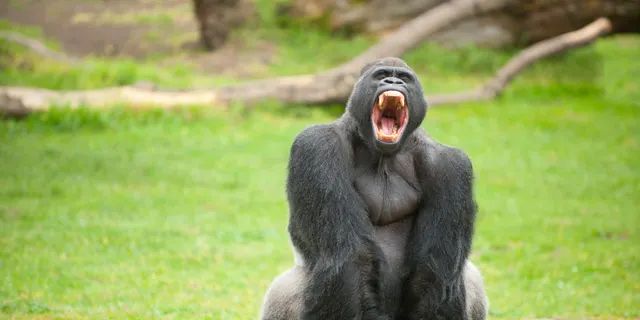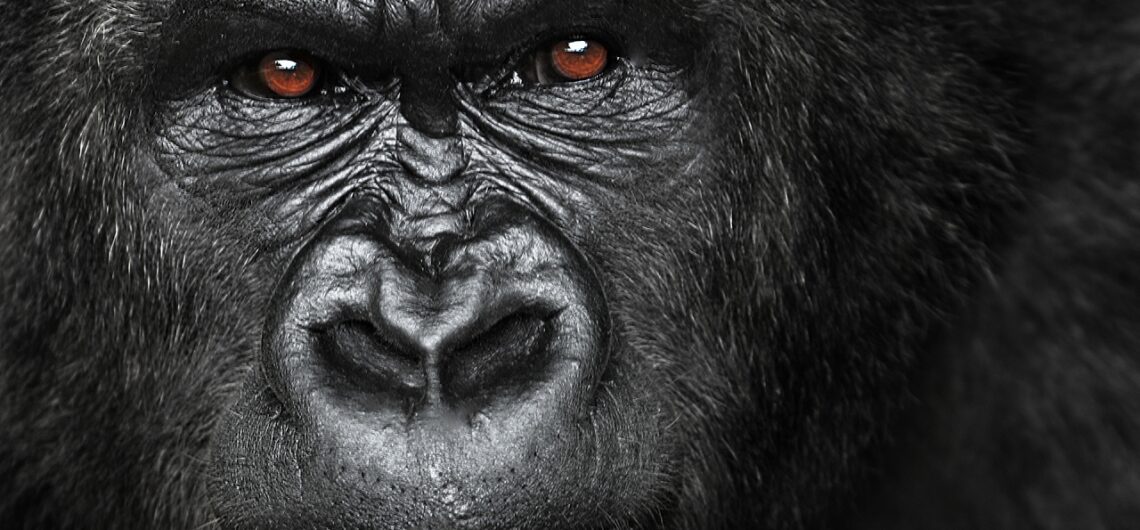How Strong is a Gorilla Compared to a Human? Gorillas are actually the largest living primates and are a native to the forests of Central and Eastern Africa found in Congo, Bwindi forest of Uganda and Virunga massif of Rwanda. They belong to the family Hominidae, which also includes Chimpanzees, Bonobos, Orangutans, and Humans as well. Interestingly, gorillas share a significant amount of genetic material with humans. In fact, humans share about 98% of their DNA with Mountain Gorillas, thus making them one of our closest living relatives.
are you wondering about how strong is a Gorilla compared to a Human? Adult male gorillas, also known as Silverbacks, can reach a height of up to 5.6ft (1.7m) when standing upright and weigh between 300 and 500 pounds (135 – 225kg). They have a muscular body with broad shoulders and a pronounced sagittal crest on top of their skull.
How strong is a Gorilla compared to a Human?
QN: So, What Makes Mountain Gorillas Sronger than Humans?
In regards to to the question of how strong is a Gorilla compared to a Human Let us use Silverback Gorillas as our reference:
-
Testosterone Levels
Testosterone is a hormone that plugs a significant role in the development and maintenance of male characteristics in many species, including gorillas. Silverback gorillas have notably higher testosterone levels compared to not only other male gorillas in the troop but also humans by a longshot.
In Mountain Gorillas, as males mature and reach sexual maturity, their testosterone levels rise significantly, thus triggering physical changes that are associated with sexual maturation, such as the growth of facial and body hair. The elevated testosterone levels in silverbacks have several effects on their physiology and behavior, contributing to their strength in many different ways.
For example, testosterone promotes the development of muscle tissues by stimulating protein synthesis and increasing muscle mass. This results in the growth of larger and stronger muscles, enhancing the overall physical strength of silverback gorillas. Testosterone also promotes bone growth and helps maintain bone strength, making the skeleton more resistant to fractures and supporting the weight of the large gorilla while they are moving about in their habitat.
Interestingly, higher testosterone levels are also associate with increased aggression and dominance behaviors in males. In context of silverback gorillas, elevated testosterone levels contribute to their dominant social status within the troop. They use displays of strength and aggression, such as chest beating and vocalizations, to establish and maintain their dominance and protect their troop.
-
Muscular Arms
The arms are a primate’s most important tool. Therefore, when we are talking about a silverback gorilla, their arms are incredibly powerful and well developed. Gorillas rely on their upper body strength for various activities such as climbing, brachiating and engaging in display of dominance. Their arm muscles, particularly the biceps, and triceps are large and robust, enabling them to support their substantial body weight and perform demanding tasks in their natural habitat.
Gorillas, as well as many other primates, have a higher proportion of fast-twitch muscle fibers compared to humans. Fast-twitch muscles are characterized by their ability to contract rapidly and generate high force output. The high proportion of fast-twitch muscle fibers in gorillas contributes to their explosive power and strength.
-
Strong Jaws
If a gorilla’s massive arms were not enough, they also come equipped with a robust jaw that can easily break a human’s skull. Gorillas possess a sagittal crest. It is most prominent in adult male gorillas, particularly silverbacks. The crest serves as an attachment point for powerful jaw muscles, including the temporalis muscle.
 The sagittal crest provides gorillas with several advantages as follows;
The sagittal crest provides gorillas with several advantages as follows;
- First, it allows for a larger surface area for the attachment of powerful muscles, enabling greater force generation during biting and chewing.
- It strengthens the skull providing support and protection against external forces, such as impacts from fights or falls.
- The robustness of the sagittal crest reflects the tremendous bite force that gorillas can exert. Speaking of bite force, studies suggest that the bite force of a silverback gorilla is estimated to be around 1,300 pounds per sq. inch or more as compared to that of an average human, which ranges between 120 – 200 pounds per sq. inch. Therefore, a silverback gorilla’s bite force is significantly greater than that of an average human.
-
Strong Teeth
In regard to strength of a Gorilla compared to a Human? Gorillas possess large and strong teeth adapted for their herbivorous diet. They have sharp incisors and canines for cutting vegetation, along with flat premolars and molars for grinding tough plant material.
QN: Does a Human Have Any Chance of Survival When They Encounter an Aggressive Silverback Gorilla?
In case of such a scenario, apply the following measures;
- Take a deep breath and remain calm: In case you encounter with an aggressive gorilla, endeavor to stay calm and do not panic, keeping it in mind that your reaction will play a vital role in the outcome of this encounter. Since it has been established that a silverback is 27 times stronger than an average human is, fighting is futile.
- Slowly stop your movements: In this case, the traveler is trying to avoid any sudden gestures that could provoke the gorilla.
- Keep a distance: Always maintain a respectful distance of at least 20 – 30ft away from the gorilla. Be careful with every step you take ensuring that you do not invade the gorilla’s personal space.
- Avoid direct eye contact: Understanding the significance of eye contact in gorilla communication, always gaze downward, demonstrating submissiveness and respect. This is because Mountain Gorillas know that direct eye contact might be a challenge and so they potentially escalate the situation.
- Resist the instinct to run: Despite any fear or adrenaline rushing through your veins, always resist the instinct to run. The attempt to flee could trigger the gorilla’s chase response.
- Back away slowly: Always back away slowly to the sides, keeping a non-threatening posture, demonstrating the intention to retreat peacefully.How strong is a Gorilla compared to a Human


Comments